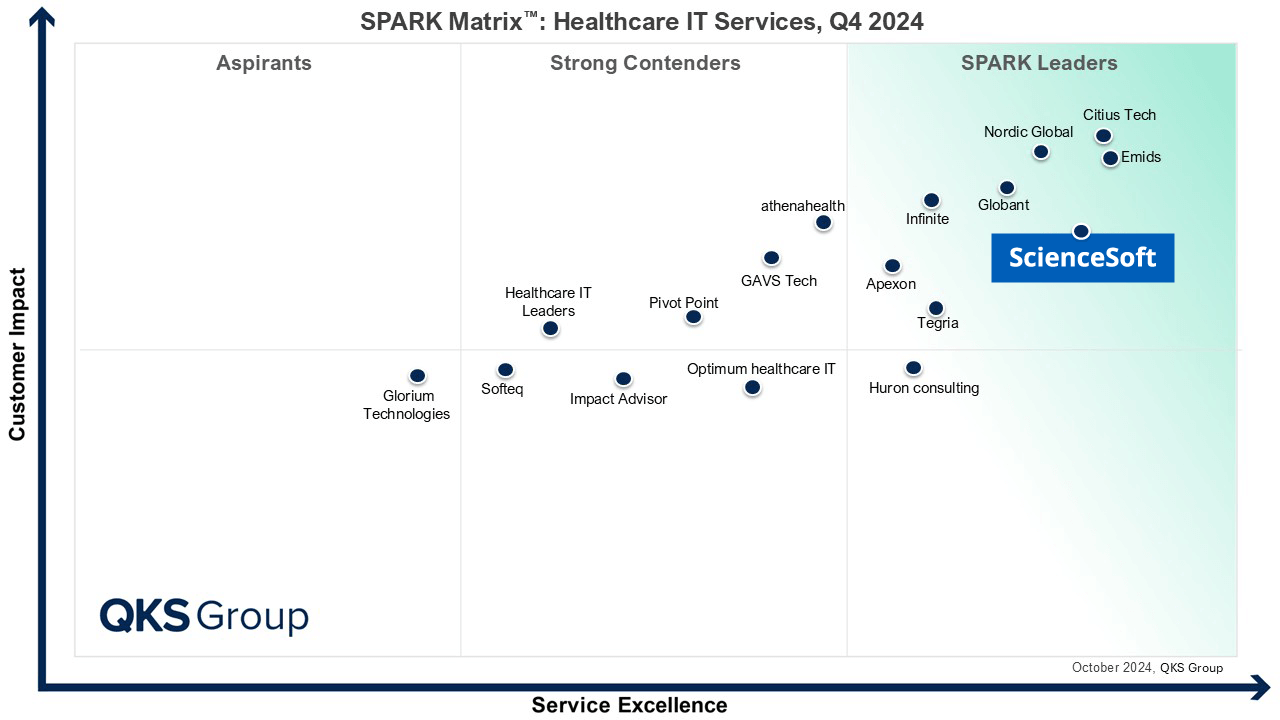Hospital App Development
Plan, Timelines, Costs
With 19 years of experience in healthcare IT, ScienceSoft designs and delivers secure hospital apps that help simplify care coordination and improve patient outcomes.
Hospital App Development in Brief
Hospital app development aims to build web and mobile apps that help streamline hospital workflows and coordinate care delivery across different clinical and administrative functions, from patient admissions to discharge planning and follow-up care.
How to build a hospital app in 7 steps
- Engineer functional requirements and plan a compliance framework (HIPAA, GDPR, etc.).
- Plan the project scope, deliverables, budget, and risks.
- Design a secure architecture and integrations with other hospital systems (e.g., EHR/EMR).
- Design role-specific UIs for nurses, doctors, admins, etc.
- Build the hospital app in 2–4 week iterations and evaluate its quality and security.
- Perform compliance checks and get the needed certifications (e.g., 510(k) clearance).
- Train the medical staff to use the app and monitor its performance.
- Development time: from 4 months for a simple app that covers one hospital process (e.g., clinical documentation management) to 12+ months for a full-fledged complex system (e.g., a remote patient monitoring solution integrated with smart devices, EHR, and doctor or nurse apps).
- Investments: From $70,000 for a simple doctor/nurse app to $2,000,000+ for an advanced system (e.g., EHR with predictive analytics, image recognition, and medical device integrations or a virtual hospital). Use our free calculator to estimate your hospital app cost.
Hospital App Market Overview
The niche of hospital apps encompasses a variety of solutions, from patient management and telemedicine platforms to nursing information systems and hospital asset tracking software. The global hospital information system market size was calculated at $157.9 billion in 2024 and is expected to reach $778.8 billion by 2034 at a CAGR of 17.3%. Other specialized software experiences similar growth, with the hospital asset management market predicted to reach a value of $76.1 billion by 2032 at a CAGR of 17.4%. The fastest-growing medical software market segment is telehealth, which is projected to grow to $285.7 billion by 2028 at a CAGR of 23.2%.
Medical Software to Cover Every Hospital Workflow
Follow the links below to learn more about the specifics of various hospital solutions and how ScienceSoft can assist you with their implementation, integration, or modernization.
Hospital management
- EHR and HIE
- Admission, discharge, and transfer (ADT) systems
- Hospital information system (HIS)
- Hospital inventory management and asset tracking software
- Healthcare data analytics
- Revenue cycle management (RCM)
- Practice management software
- Appointment management apps
- Healthcare CRM
- AR/VR for medical staff training
Treatment management
- Diagnostic software
- Drug prescription assistance and clinical decision support software (CDS)
- Computerized physician order entry (CPOE) and nursing information systems (NIS)
- Pharmacy information systems (PIS)
- Lab management and information software (LIS)
- Medical image analysis software
- Picture archiving and communication systems (PACS)
- AR/VR for surgery planning
Patient engagement
- Patient portals
- Patient engagement apps
- Chronic disease management
- Telemedicine apps
- Remote patient monitoring software
- Healthcare AI chatbots
- Inpatient care apps
- Outpatient care apps
How to Build a Hospital App: Sample Plan
The hospital app development process will largely depend on your app's purpose, complexity, and target users (healthcare specialists, patients, admins). ScienceSoft's consultants created a sample plan drawing on our 19 years of experience in the field.

1.
Conceptualization and requirements gathering
The first step is determining the purpose of your hospital app, its target users, and its core features. If the application is developed for internal use, business analysts examine the existing hospital workflows and IT ecosystem and interview stakeholders to reveal their specific needs. Commercial hospital apps require a market analysis stage to determine their audience, competitors, and potential return on investment (ROI).
All the information gathered by business analysts is used to engineer software requirements and translate them into an optimal feature set. For example, a custom care coordination app for a hospital network would need to closely follow the hospital’s established workflows and seamlessly exchange data with other software systems in place. On the other hand, a commercial hospital app product would benefit from having ready-to-use APIs for integration with other popular systems on the market, such as EHRs, billing systems, or telehealth platforms. Quality-of-life features such as voice-to-text for faster note-taking would boost software adoption in both cases.
Software requirements should also include non-functional requirements, such as security measures (data encryption, backup and recovery, and multifactor authentication), performance requirements (e.g., the expected user load), and usability requirements.
This stage also includes defining a compliance strategy. For instance, US hospital apps must comply with HIPAA regulations, and if the app incorporates medical device functionality, it may additionally require FDA approval (learn more in the pre-launch activities step below).
Finally, all the requirements are outlined in a software requirements specification (SRS), which helps to establish a structured development process.
2.
Project planning
Project managers start by creating a project plan that outlines the project’s scope, delivery schedule, and budget. The plan largely depends on the chosen approach to project management (e.g., Scrum, Kanban), which also determines the resources needed for the project. In addition, project managers conduct a project risk assessment and develop a risk mitigation plan that they will follow and update throughout the project.
3.
Architecture design
Using the software requirements specification, solution architects design a secure and reliable architecture for the future hospital app. Depending on the project specifics, they plan the necessary integrations (e.g., with EHR, CRM, LIS, and telemedicine platforms). To ensure seamless interoperability between systems, the app will need to support uniform data exchange standards like HL7, FHIR, and DICOM.
For a complex hospital mobile app (e.g., telemedicine, digital therapeutics), microservices-based architecture may be a good choice. It's easy to launch, scale, and maintain such apps, as each service operates autonomously, so you won’t need to recode the entire system to add a single feature. Also, if one microservice fails, it won’t impact the performance of other microservices.
4.
UX and UI design
At this stage, UX and UI experts study the future app’s user roles and permissions to plan user journeys and design intuitive interfaces. Usability is one of the crucial aspects of a hospital application, especially if it is patient-oriented. It should be made accessible for geriatric patients and people with auditory or visual impairments or cognitive disabilities. For hospital mobile app development, the interface should be perceivable, operable, understandable, and robust. Some of the Mobile Content Accessibility Guidelines (MCAG) include:
-
High color contrast between the text and its background and the option to scale the font size.
-
No content that flashes more than three times per second to reduce the risk of seizures.
-
Single-pointer alternatives for complex gestures and drag-and-drop elements.
5.
Development and testing
At ScienceSoft, we usually recommend starting with a minimum viable product (MVP). This approach allows our clients to launch their software as fast as possible and rapidly adjust it according to user feedback.
Typically, developers build the app’s front end and back end in 2–4 week iterations, following secure coding standards and implementing patient data protection measures. This stage also includes integrating the app with other hospital IT systems (e.g., practice management system, EHR, medical imaging software, medical devices) directly or via APIs.
Ensuring the high quality of software requires thorough testing, which is usually performed in parallel with development in Agile projects. QA engineers check the hospital app against its functional requirements, evaluate its security through code reviews and pentesting, conduct stress tests to check the app’s performance, and assess the app’s usability and accessibility. They also ensure that all the integrations with other healthcare solutions function properly.
6.
Pre-launch activities
At this stage, QA engineers conduct a HIPAA or GDPR compliance pre-audit. FDA/MDR submission may be required if the hospital app has SaMD features. However, if the SaMD functionality is similar to that of an already marketed device or app, you can submit your software for a streamlined clearance procedure (e.g., FDA 510(k)).
It’s also advisable to conduct a pilot roll-out to a focus group (e.g., a group of nurses in a hospital). This will help evaluate initial user satisfaction and adjust the app according to the feedback.
As regulatory clearance is a lengthy process, we start developing the necessary documentation as early as the discovery stage and keep later project documentation in line with the submission requirements to avoid losing precious information and time.
7.
Launch, support, and evolution
After the hospital app’s deployment, medical staff require comprehensive training to perform their tasks efficiently. Prompt troubleshooting and user support will also significantly contribute to smooth software adoption.
The app’s performance should be closely monitored to identify areas for improvement (e.g., cloud consumption optimization). Later, new features can be introduced, or old capabilities can be updated based on user feedback and changing business needs.
About ScienceSoft
- 35 years in software development and 19 years in healthcare IT.
- 150+ successful healthcare IT projects.
- ISO 13485, ISO 9001, and ISO 27001 certificates.
- Hands-on experience with HIPAA, GDPR, FDA, ONC, MDR, SAMHSA, CEHRT, and SAFER regulations.
- Proficiency in healthcare standards such as HL7/FHIR, ICD-10, LOINC, CPT, XDS/XDS-I, DICOM, Blue Button+, CDA, and CCD.
Our Awards and Recognitions

Listed among Healthcare IT Service Leaders in 2022 and 2024
Growing faster than Amazon, Google, and ServiceNow
Recognized for reliability and trustworthiness
Recognized by Health Tech Newspaper awards for the third time

Top Healthcare IT Developer and Advisor by Black Book™ survey 2023
Best in class in medical device connectivity (2023)
A top outsourcing provider for three consecutive years
ISO 13485-certified quality management system
ISO 27001-certified security management system
Check Out Our Hospital App Demo

Hospital App Demo
Check out our interactive physician app demo to see how a hospital app would work on a tablet.
Hospital App Development Sourcing Models
Technologies We Use for Hospital App Development
How Much Does It Cost to Build a Hospital App?
Here are the main cost factors to consider:
- Functional scope. Advanced features like real-time analytics or medical AI capabilities will significantly increase the app’s cost.
- The supported platforms (web, mobile, desktop) and development approach (e.g., native vs. cross-platform for mobile), technology stack, and architecture complexity.
- Integrations with other healthcare systems and medical devices.
- The expected number of user roles and users.
- Regulatory compliance requirements (HIPAA, GDPR, etc.).
- Non-functional requirements (e.g., security, usability, performance).
- Sourcing model (in-house development vs. outsourcing).
The cost of hospital app development may vary from $70,000 to $2,000,000+. Below are sample cost ranges for commonly requested software types.
$100,000–250,000
For a patient management app with patient registration, appointment scheduling, notifications, and basic telemedicine functionality.
$150,000–$250,000
For a hospital management app with staff scheduling, inventory management, patient tracking, billing, and analytics capabilities.
$300,000–$400,000
For a telemedicine app that enables real-time patient vitals monitoring via connected medical devices.
$400,000–$800,000
For an EHR system that’s tailored to a medical specialty and integrated with healthcare IT systems (e.g., HIE, CRM, etc.)
$800,000–$3,000,000
For a large-scale virtual hospital with remote patient monitoring functionality and advanced clinical decision support modules.

